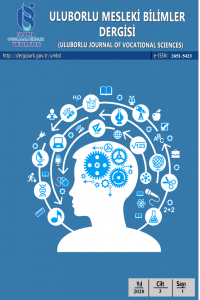GELENEKTEN GELECEĞE: 3D YAZICILAR İLE EHRAM KUMAŞA DESEN UYGUNMASININ İNCELENMESİ
Dünyada giderek önem kazanan teknolojik inovasyonlar beraberinde Dördüncü Sanayi Devrimini getirmiştir. Bu devrim ile birlikte ortaya çıkan fiziksel megatrend teknolojilerinin başında 3D baskı ve yazıcılar gelmektedir. Endüstri 4.0 teknolojilerinin en somut göstergesi olan 3D baskı, eklemeli imalat olarak adlandırılan fiziksel nesne oluşturulmasını ifade etmektedir. Bu teknoloji, Türkiye ve Dünya endüstrisinin lokomotifi olan tekstil sektöründe kendine desen, tasarım ve imalat uygulamasında alan bulmaktadır. Bu kapsamda 3D baskı teknolojisinin müşteriye özel, özgün tasarım imkânı sunan, niş ürünlerin oluşturularak satış yapılma imkânı sağlaması beklenmektedir. Böylece yöresel desen tasarımına imkân veren ve bu desenlerin yöresel tekstil ürünleri olan Ehram ürünlerine uygulanmasına olanak sağlar. Ehram/ihram, ince eğrilmiş koyunyününden yapılan, düz yüzeyli mekikli dokumadan elde edilen kadın-erkek giysisi, ev dekorasyon ürünü, hediyelik eşya gibi kullanım alanı olan kumaştır. Bu çalışma ile geleneksel ürün olan Ehramın 3D yazıcılar ile desen uygulanması incelenmektedir. 3D yazıcı malzemesi olarak Selüloz türevli katılma polimerleri (Polyetilen, polipropilen, vinil akrilikler, flüorokarbon reçineleri ve polistirenler) ve yoğunlaşma polimerleri (naylonlar, Polyetilen tereftalat, polikarbonatlar ve poliamitler) gibi kompozit yapıdaki malzeme kullanılmaktadır.
Anahtar Kelimeler:
3D Yazıcılar, Ehram, Endüstri 4.0, Desen, Tekstil
FROM THE TRADITION TO THE FUTURE: INVESTIGATION OF PATTERN APPLICATION TO EHRAM FABRIC WITH 3D PRINTERS
Technological innovations, which have become increasingly important in the world, brought with it the Fourth Industrial Revolution. 3D printing and printers are at the top of the physical megatrend technologies that emerged with this revolution. 3D printing, which is the most concrete indicator of Industry 4.0 technologies, refers to the creation of a physical object called additive manufacturing. This technology, which is the locomotive of Turkey and the world industry textile industry in its pattern, is to find space in the design and manufacturing practices. In this context, it is expected that 3D printing technology will provide the opportunity to make sales by creating niche products that offer customer-specific, original design opportunities. Thus, it enables local pattern design and the application of these patterns to Ehram products, which are local textile products. Ehram / ihram is a fabric made of fine spun sheep wool, which is made of flat-surfaced shuttle weaving and has a usage area such as women's and men's clothing, home decoration products, souvenirs. In this study, the application of the traditional product Ehram with 3D printers is examined. It is possible to use composite materials such as cellulose-derived additive polymers (Polyethylene, polypropylene, vinyl acrylics, fluorocarbon resins and polystyrenes) and condensation polymers (nylons, Polyethylene terephthalate, polycarbonates and polyamides) as 3D printer materials.
Keywords:
3D Printers, Ehram, Industry 4.0, Pattern, Textile,
___
- Y. Esmer ve M. A. Alan, «ENDÜSTRİ 4.0 PERSPEKTİFİNDE İNOVASYON,» AVRASYA Uluslararası Araştırmalar Dergisi, cilt 7, no. 18, pp. 465-478
- F. Chiarelloa, L. Trivellib, A. Bonaccorsia ve G. Fantonic, «Extracting and mapping industry 4.0 technologies using wikipedia,» Computers in Industry, no. 100, pp. 244-257, 2018.
- L. D. Xu, E. L. Xu ve L. Li, «Industry 4.0: state of the art and future trends,» International Journal of Production Research, cilt 56, no. 8, pp. 2941-2962, 2018.
- K. Schwab, The Fourth Industrial Revolution (Dördüncü Sanayi Devrimi), S. Talay, Dü., İstanbul: Optimist, 2018. ATSO, «ANTALYA FİRMALARINA YÖNELİK ENDÜSTRİ 4.0 DURUM TESPİTİ,» Antalya, 2017.
- E. Bulut ve T. Akçacı, «ENDÜSTRİ 4.0 VE İNOVASYON GÖSTERGELERİ KAPSAMINDA TÜRKİYE ANALİZİ,» ASSAM International Refereed Journal, no. 7, pp. 50-72, 2017.
- J. Hearle, «Advances in 3D Textiles,» Woodhead Publishing Series in Textiles, 2015, pp. 1-18.
- A. Ehrmann, «3D printing in the textile chain,» 09 Kasım 2017. [Çevrimiçi]. Available: https://www.wtin.com/article/2017/november/061117/3d-printing-in-the-textile-chain/.
- D. Zapfl, «How 3D printing in the textile industry is leading into a new era,» 03 04 2019. [Çevrimiçi]. Available: https://www.lead-innovation.com/english-blog/3d-printing-in-the-textile-industry. [Erişildi: 25 03 2021].
- Y. Esmer, A. Özbek ve M. A. Alan, «Tekstil İşletmelerinde İnovasyon Uygulamalarına Yönelik Bir Araştırma: İstanbul Sanayi Odası Örneği,» Girişimcilik İnovasyon ve Pazarlama Araştırmaları Dergisi, cilt 3, no. 6, pp. 129 - 144, 2019.
- O. Saltık ve A. Özsoy , "BAĞLAYICI PÜSKÜRTMELİ METAL EKLEMELİ İMALATTA KULLANILAN BAĞLAYICILAR", Uluborlu Mesleki Bilimler Dergisi, vol. 3, no. 1, pp. 10-18, 2021.
- A. Valtas ve D. Sun, «3D Printing for Garments Production: An Exploratory Study,» Journal of Fashion Technology & Textile Engineering, cilt 4, no. 3, pp. 1-4, 2016.
- M. Yıldıran, «MODA GİYİM SEKTÖRÜNDE ÜÇ BOYUTLU YAZICILARLA TASARIM VE ÜRETİM,» Süleyman Demirel Üniversitesi Güzel Sanatlar Fakültesi Hakemli Dergisi, no. 17, pp. 155-172, 2016.
- Roboturk, Available: https://shop.3droboturk.com/index.php?route=product/product&product_id=50. [Erişildi: 13 Mart 2019].
- M. Cornforth, «Functionality drives 3D printing,» 13 Haziran 2017. [Çevrimiçi]. Available: https://www.wtin.com/article/2017/june/120617/functionality-drives-3d-printing/.
- Z. Hay, «3D Printed Fabric: The Most Promising Projects,» 07 11 2019. [Çevrimiçi]. Available: https://all3dp.com/2/3d-printed-fabric-most-promising-project/. [Erişildi: 25 03 2021].
- Fabtextiles, 27 Nisan 2016. [Çevrimiçi]. Available: http://fabtextiles.org/tag/3d-print-on-fabric/.
- Milli Eğitim Bakanlığı, EL SANATLARI TEKNOLOJİSİ/EHRAM DOKUMA, Ankara, 2012.
- F. N. Başaran, «BAYBURT YÖRESİNDE GELENEKSEL "EHRAM DOKUMACILIĞI" ÜRETİM TEKNİKLERİ, MOTİF VE KOMPOZSİYON ÖZELLİKLERİ,» Millî Folklor, no. 104, pp. 151-166, 2014.
- Erzurum İl Kültür ve Turizm Müdürlüğü,» [Çevrimiçi]. Available: http://www.erzurumkulturturizm.gov.tr/TR-176363/ehram.html. [Erişildi: 13 Mart 2019].
- Bayburt Valiliği, [Çevrimiçi]. Available: http://www.bayburt.gov.tr/el-sanatlari. [Erişildi: 13 Mart 2019].
- Ş. Elçi, İnovasyon Rehberi: Kârlılık ve Rekabetin Elkitabı, Ankara: İNOMER, 2014.
- Ö. Çınar, S. Altuntaş ve M. A. Alan, «Technology transfer and its impact on innovation and firm performance: empirical evidence from Turkish export companies,» Kybernetes, 2020.
- ISSN: 2651-5423
- Başlangıç: 2018
- Yayıncı: Isparta Uygulamalı Bilimler Üniversitesi
Sayıdaki Diğer Makaleler
TORKMETRE CİHAZININ TASARIMI, ANALİZİ VE TEST EDİLMESİ
İsmail BÖĞREKCİ, Pınar DEMİRCİOĞLU, Göktuğ ÖZER
DÖKME MALZEMENİN EKSKAVATÖR KEPÇESİ ÜZERİNDEKİ ETKİLEŞİMLİ ETKİLERİNİN ANALİZİ
Pınar DEMİRCİOĞLU, İsmail BÖĞREKCİ, Salim HAMISU
GELENEKTEN GELECEĞE: 3D YAZICILAR İLE EHRAM KUMAŞA DESEN UYGUNMASININ İNCELENMESİ
